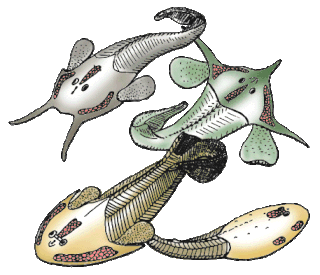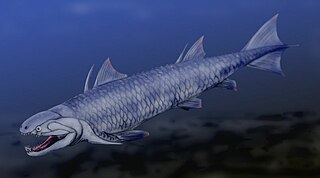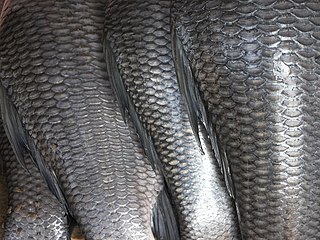Related Research Articles

Chondrichthyes is a class that contains the cartilaginous fishes that have skeletons primarily composed of cartilage. They can be contrasted with the Osteichthyes or bony fishes, which have skeletons primarily composed of bone tissue. Chondrichthyes are jawed vertebrates with paired fins, paired nares, scales, and a heart with its chambers in series. Extant chondrichthyes range in size from the 10 cm finless sleeper ray to the over 10 m whale shark.

In most biological nomenclature, a scale is a small rigid plate that grows out of an animal's skin to provide protection. In lepidopteran species, scales are plates on the surface of the insect wing, and provide coloration. Scales are quite common and have evolved multiple times through convergent evolution, with varying structure and function.

Catfish are a diverse group of ray-finned fish. Named for their prominent barbels, which resemble a cat's whiskers, catfish range in size and behavior from the three largest species alive, the Mekong giant catfish from Southeast Asia, the wels catfish of Eurasia, and the piraíba of South America, to detritivores, and even to a tiny parasitic species commonly called the candiru, Vandellia cirrhosa. Neither the armour-plated types nor the naked types have scales. Despite their name, not all catfish have prominent barbels or "whiskers". Members of the Siluriformes order are defined by features of the skull and swimbladder. Catfish are of considerable commercial importance; many of the larger species are farmed or fished for food. Many of the smaller species, particularly the genus Corydoras, are important in the aquarium hobby. Many catfish are nocturnal, but others are crepuscular or diurnal.

Agnatha is an infraphylum of jawless fish in the phylum Chordata, subphylum Vertebrata, consisting of both present (cyclostomes) and extinct species. Among recent animals, cyclostomes are sister to all vertebrates with jaws, known as gnathostomes.

Gnathostomata are the jawed vertebrates. Gnathostome diversity comprises roughly 60,000 species, which accounts for 99% of all living vertebrates, including humans. In addition to opposing jaws, living gnathostomes have true teeth, paired appendages, the elastomeric protein of elastin, and a horizontal semicircular canal of the inner ear, along with physiological and cellular anatomical characters such as the myelin sheaths of neurons, and an adaptive immune system that has the discrete lymphoid organs of spleen and thymus, and uses V(D)J recombination to create antigen recognition sites, rather than using genetic recombination in the variable lymphocyte receptor gene.

Fish anatomy is the study of the form or morphology of fish. It can be contrasted with fish physiology, which is the study of how the component parts of fish function together in the living fish. In practice, fish anatomy and fish physiology complement each other, the former dealing with the structure of a fish, its organs or component parts and how they are put together, such as might be observed on the dissecting table or under the microscope, and the latter dealing with how those components function together in living fish.

Cladoselache is an extinct genus of shark-like chondrichthyan from the Late Devonian (Famennian) of North America. It was similar in body shape to modern lamnid sharks, but was not closely related to lamnids or to any other modern (selachian) shark. As an early chondrichthyan, it had yet to evolve traits of modern sharks such as accelerated tooth replacement, a loose jaw suspension, enameloid teeth, and possibly claspers.

Ostracoderms are the armored jawless fish of the Paleozoic Era. The term does not often appear in classifications today because it is paraphyletic and thus does not correspond to one evolutionary lineage. However, the term is still used as an informal way of loosely grouping together the armored jawless fishes.

Loricariidae is the largest family of catfish, with 92 genera and just over 680 species. Loricariids originate from freshwater habitats of Costa Rica, Panama, and tropical and subtropical South America. These fish are noted for the bony plates covering their bodies and their suckermouths. Several genera are sold as "plecos", notably the suckermouth catfish, Hypostomus plecostomus, and are popular as aquarium fish.

Loricarioidea is a superfamily of catfishes. It contains the six families Trichomycteridae, Nematogenyiidae, Callichthyidae, Scoloplacidae, Astroblepidae, and Loricariidae. Some schemes also include Amphiliidae. This superfamily, including Amphiliidae, includes about 156 genera and 1,187 species.

Psarolepis is a genus of extinct bony fish which lived around 397 to 418 million years ago. Fossils of Psarolepis have been found mainly in South China and described by paleontologist Xiaobo Yu in 1998. It is not known certainly in which group Psarolepis belongs, but paleontologists agree that it probably is a basal genus and seems to be close to the common ancestor of lobe-finned and ray-finned fishes. In 2001, paleontologist John A. Long compared Psarolepis with onychodontiform fishes and refer to their relationships.
Andreolepis is an extinct genus of prehistoric fish, which lived around 420 million years ago. It was described by Walter Gross in 1968 based on scales found in the Hemse Formation in Gotland, Sweden. It is placed in the monogeneric family Andreolepididae and is generally regarded as a primitive member of the class Actinopterygii based on its ganoid scale structure; however some new research regards it as a stem group of osteichthyans.

A tooth is a hard, calcified structure found in the jaws of many vertebrates and used to break down food. Some animals, particularly carnivores and omnivores, also use teeth to help with capturing or wounding prey, tearing food, for defensive purposes, to intimidate other animals often including their own, or to carry prey or their young. The roots of teeth are covered by gums. Teeth are not made of bone, but rather of multiple tissues of varying density and hardness that originate from the outermost embryonic germ layer, the ectoderm.

A fish scale is a small rigid plate that grows out of the skin of a fish. The skin of most jawed fishes is covered with these protective scales, which can also provide effective camouflage through the use of reflection and colouration, as well as possible hydrodynamic advantages. The term scale derives from the Old French escale, meaning a shell pod or husk.
Enameloid, also known as durodentine or vitrodentine, is an enamel-like tissue found in many fish. It is the primary outer component of shark odontodes. Although the origin of enameloid is debated, it is probably homologous to dentine rather than true enamel, despite its enamel-like strength and development. The term covers any hyper-mineralized tissue with an organic "scaffold" consisting of ectodermal and ectomesenchymal proteins.

Most bony fishes have two sets of jaws made mainly of bone. The primary oral jaws open and close the mouth, and a second set of pharyngeal jaws are positioned at the back of the throat. The oral jaws are used to capture and manipulate prey by biting and crushing. The pharyngeal jaws, so-called because they are positioned within the pharynx, are used to further process the food and move it from the mouth to the stomach.

Fins are distinctive anatomical features composed of bony spines or rays protruding from the body of Actinopterygii and Chondrichthyes fishes. They are covered with skin and joined together either in a webbed fashion, as seen in most bony fish, or similar to a flipper, as seen in sharks. Apart from the tail or caudal fin, fish fins have no direct connection with the spine and are supported only by muscles. Their principal function is to help the fish swim.

The evolution of fish began about 530 million years ago during the Cambrian explosion. It was during this time that the early chordates developed the skull and the vertebral column, leading to the first craniates and vertebrates. The first fish lineages belong to the Agnatha, or jawless fish. Early examples include Haikouichthys. During the late Cambrian, eel-like jawless fish called the conodonts, and small mostly armoured fish known as ostracoderms, first appeared. Most jawless fish are now extinct; but the extant lampreys may approximate ancient pre-jawed fish. Lampreys belong to the Cyclostomata, which includes the extant hagfish, and this group may have split early on from other agnathans.
Cosmine is a spongy, bony material that makes up the dentine-like layers in the scales of the lobe-finned fishes of the class Sarcopterygii. Fish scales that include layers of cosmine are known as cosmoid scales.

Romundina is a small, heavily armored extinct genus of acanthothoracid placoderms which lived in shallow marine environments in the early Devonian (Lochkovian). The name Romundina honors Canadian geologist and paleontologist Dr. Rómundur (Raymond) Thorsteinsson of Calgary, Alberta, Canada. Romundina are believed to have lived on Earth between 400 and 419 million years ago. The closest known relative to Romundina is the acanthothoracid Radotina. The type and only described species is R. stellina.
References
- ↑ "Paleos Vertebrates: Glossary". Archived from the original on 2006-06-22. Retrieved 2006-05-21.
- ↑ "Evolution of development of the vertebrate dermal and oral skeletons: Unraveling concepts, regulatory theories, and homologies". Paleobiology. 2002.
- ↑ "Sexual Dimorphism of the "Zebra Pleco" Hypancistrus zebra". Archived from the original on 2006-05-16. Retrieved 2006-05-22.
- ↑ Dhouailly, Danielle; Godefroit, Pascal; Martin, Thomas; Nonchev, Stefan; Caraguel, Flavien; Oftedal, Olav (April 2019). "Getting to the root of scales, feather and hair: As deep as odontodes?". Experimental Dermatology. 28 (4): 503–508. doi: 10.1111/exd.13391 . ISSN 0906-6705. PMID 28603898. S2CID 38481860.
- ↑ Aquino, Adriana E.; Schaefer, Scott A.; Miquelarena, Amalia M. (June 2001). "A New Species of Hisonotus (Siluriformes, Loricariidae) of the Upper Río Uruguay Basin". American Museum Novitates (3333): 1–12. doi:10.1206/0003-0082(2001)333<0001:ANSOHS>2.0.CO;2. ISSN 0003-0082. S2CID 7469285.